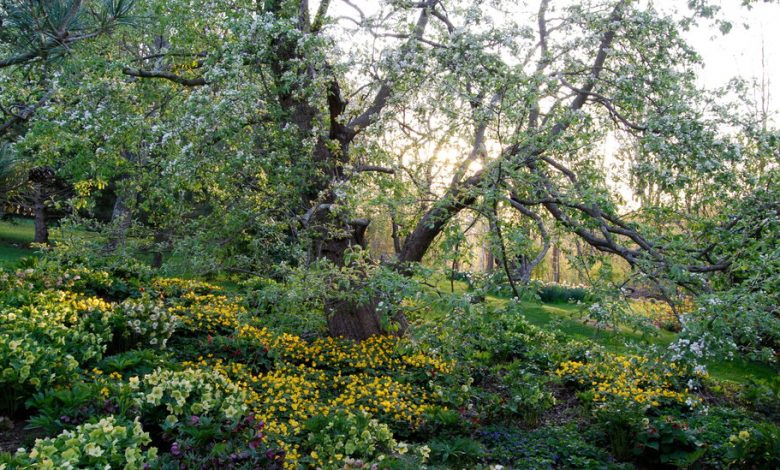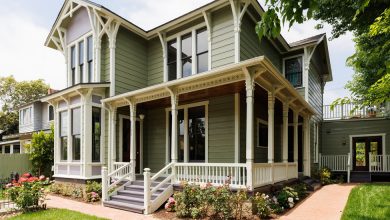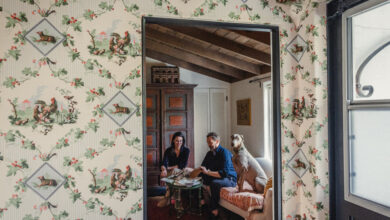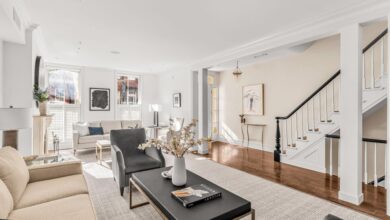In Your Enthusiasm for Planting, Don’t Forget About the Trees

If trees could talk, they’d probably start by saying, “Enough with the insults already.”
In more than 30 years of working with trees, Christopher Roddick has made it a practice to listen to their unspoken language — and to show respect for some of the largest and oldest organisms among us.
Mr. Roddick is the head arborist and foreman of grounds at Brooklyn Botanic Garden, a post he is leaving this summer, when he and his wife, Rebecca McMackin, the director of horticulture at Brooklyn Bridge Park, move north. Their first stop: a fellowship she is doing at Harvard.
But Mr. Roddick won’t forget the trees at the botanic garden — old friends, by now — and what they have taught him. Especially about how we oblivious humans expect them to adapt to our garden-making and home improvements, rather than the other way around. Too often, we don’t take into account in the needs of our trees.
“As an arborist, I usually don’t get the call until a tree is in trouble,” he said. “And I ask, ‘Has anything changed around it?’”
At first, the answer is almost always “No” — and then something like, “Well, we put the patio in nearby. But that was five years ago.”
“A tree can hold its breath for a few years, but then…,” Mr. Roddick said, trailing off, as if preferring not to recall all the bad outcomes. “When you’re attacked, you defend yourself. But for a tree, that means without being able to get away.”
Trees have adapted, making compounds to help fend off herbivory and fungal infections. But there is no chemical strong enough for some of what we wreak: We dig in or drive over their root zones. We prune, not because a tree needs it, but because a garden bed below has grown too shady for our liking. We strand a tree in a sea of lawn, where it is exposed to unwanted fertilizer and an automated watering schedule.
“I’m not a big fan of planting a tree out in the middle of the lawn,” Mr. Roddick said. “Most shade trees we use are forest species, and they often do better growing in a group.”
Understory trees, for example, like flowering dogwood (Cornus florida), are not suited to baking in full sun.
Beyond Ornamental Horticulture
The way Mr. Roddick sees trees has shifted since he first studied ornamental horticulture.
“I learned about trees from the point of view of selecting species because of their ornament — of what’s in it for us to look at or eat,” he said.
But a tree’s appearance is not the whole story.
“When you look at a tree, you’re only seeing part of it,” he said. “But a third to half of its mass is underground — massive root systems that are mostly in the top 18 inches of soil.” In compacted urban soil, they might be in the top six inches.
Today, he is more in the mind-set of ecological landscaping than ornamental horticulture. He takes an ecosystem view, recommending species that help create habitat.
He asks himself: “Can I use some of the insights I have seen in nature to inform my use and care of trees?”
That might mean arranging several trees close together, underplanted with native sedge (Carex). And perhaps leaving fallen trees in place, to decompose on site. As they break down, these nurse logs, as they are called, cycle nutrients back into the soil and can support seedling trees, the next generation.
The way he thinks is not the way most of us think, but trees might be happier if it were.
What Makes for Resilience in a Tree?
A key takeaway for Mr. Roddick: Not all species or individuals react the same way to changes. Similar actions by gardeners may trigger very different effects, depending on the kind of tree, its life stage and its overall health.
Trees with very heavy, woody root systems, like white oak (Quercus alba), are not as flexible about disturbance as a fibrous-rooted species like dawn redwood (Metasequoia glyptostroboides).
“If I knew I was going to establish a garden, and I wanted a plant that’s easy to work around, Metasequoia is one I would feel pretty comfortable with,” he said. “I’m not going to be able to dig around trees like white oak very much. Especially as it ages, it handles disturbance much less.”
A fairly young tree, with more resources to draw upon, can be more forgiving.
Where damage or disease occurs, species-specific differences in resilience show, too. Some trees are better at compartmentalizing — at walling off a wounded or decaying section to protect the larger organism. Oaks are fairly adept at this, Mr. Roddick said, which contributes to their generally long life spans.
At the other extreme are willows, cherries and magnolias, which are very poor at compartmentalizing. As he put it, they’re “more the live-fast-die-young model.”
The Reality (and Gift) of Shade
Trees cast shade. That’s the good news, especially in a warming world. But many gardeners balk when the shade foils plans for growing plants like tomatoes or roses.
Mr. Roddick recalls one client who dreamed of a rose garden at her new home, where there was a mature sycamore maple (Acer pseudoplatanus).
“I suggested doing shade gardening instead, to preserve the tree, but it wasn’t to be,” he said. “People want more light for the lawn or garden, as opposed to designing around the established shade trees.”
A common request: Couldn’t he limb the tree up or open its canopy to let in more light? His answer is invariably based on the species, its health and its age.
“Better to train a young tree to fit into a garden, as opposed to trying to change an old tree,” he said. “If we have to prune part of an established tree to open it up, does it have enough reserved resources to remain a healthy and safe tree?”
The client got her rose garden, but at the tree’s expense. It went into a decline, became a safety hazard and eventually had to come down.
Creating a Living Mulch Layer
Often the problem is “death by a thousand cuts,” Mr. Roddick said, when we garden too aggressively in the root zone. Or worse, if an irrigation system is installed, slicing repeatedly through the tree’s lifelines.
He is a proponent of “living green mulch, not a ring of bark mulch.” But transforming an area under established woody plants into a ground-covering, herbaceous layer requires a gentle hand and patience.
“You need to start with small plants or divisions and dig very little holes,” he said.
Think soil knife, not shovel: With larger tools (or plants), the tree roots will get chopped up. “A few is no big deal,” he said. “But when you’re disturbing lots of roots, that can affect the tree.”
Another all-too-frequent insult: adding soil over tree roots to accommodate plantings.
“Now the tree roots are buried, and they’re not getting oxygen,” Mr. Roddick said. “How water moves through the root zone is going to change.”
The roots may start growing up into the new soil to find those resources, but that can backfire if they dry out or are overwatered, which can lead to a number of problems, including root-rot diseases.
Some Favorite Trees (But Skip the Fertilizer)
Rarely has Mr. Roddick fertilized the trees in his care.
In a forest environment, nitrogen is not very plentiful, he said, so trees don’t need a lot of it. Applying fertilizer that is high in nitrogen (even inadvertently, when feeding an adjacent lawn) can be costly to a tree. “You’re not giving it food; the tree makes its own through photosynthesis,” he said.
“Nitrogen stimulates growth,” he explained, but that means the tree “has to pull from its reserve and pay for that growth. You could actually be depleting its reserves by forcing it to grow artificially.”
One exception is a tree grown in a large container, which you water frequently, flushing out the soil nutrients. But with trees growing in the ground, there’s a better approach than applying fertilizer: Let fallen leaves lie in place in autumn, so that they gradually return nutrients to the soil.
When Mr. Roddick lectures these days, he frequently ends with an ecological message: “Plant trees, mostly natives — and save as many old ones as you can.”
Those he recommends include sourwood (Oxydendrum arboreum), often promoted for its summer flowers and fall foliage, although he loves “its winter aesthetics, all gnarly, with seedpods hanging down.” This is a tree he likes to see planted in a group.
At Brooklyn Botanic Garden’s native flora garden, he came to appreciate the showy bark of the shade-adapted striped maple or moosewood (Acer pensylvanicum).
The botanic garden has a redbud (Cercis canadensis) collection, too, and in front of their Brooklyn home, he and Ms. McMackin planted the purple-leaved cultivar Forest Pansy, for the hundreds of hearts that hang from its branches.
Fringetree (Chionanthus virginicus), good for small gardens, features fragrant white spring flowers and yellow fall color (as well as blue fruit on female plants). One downside: It is susceptible to the emerald ash borer.
Pawpaw (Asimina triloba) has it all: flowers, fall color and fruit, with a custardy texture and complex flavor.
And Mr. Roddick wouldn’t be without fast-to-establish sassafras (Sassafras albidum), which has distinctively shaped leaves that fire up in autumn. Yes, it requires management to discourage the formation of a colony.
But then again, a whole stand of sassafras wouldn’t be so bad, he allowed: “I would spend my whole fall just sitting underneath there.”
Margaret Roach is the creator of the website and podcast A Way to Garden, and a book of the same name.
For weekly email updates on residential real estate news, sign up here. Follow us on Twitter: @nytrealestate.






